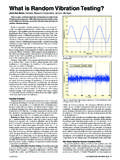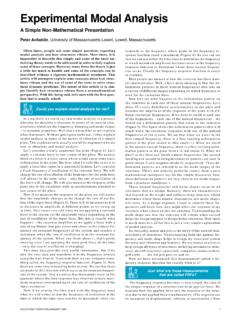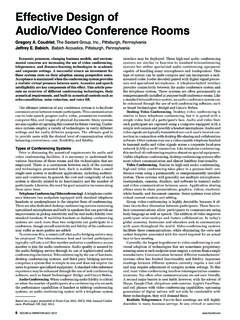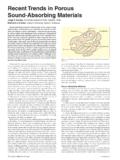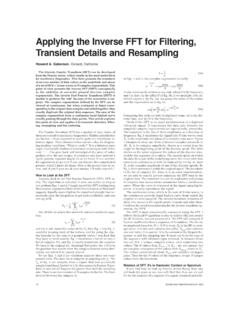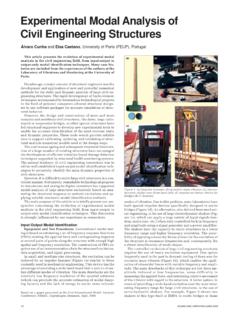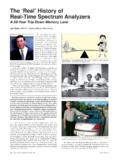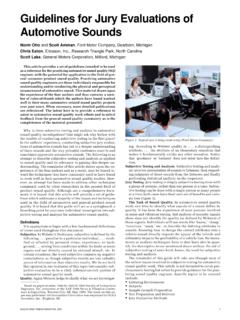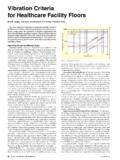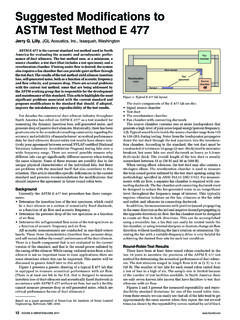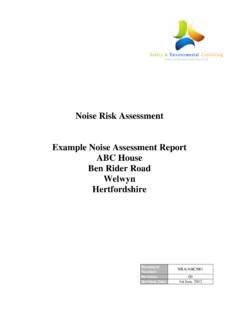Transcription of Engineering Controls for Occupational Noise …
1 SOUND & VIBRATION/JANUARY 2012 Despite significant advances in hearing protection technology, Hearing Conservation Programs are not an adequate substitute for Engineering and administrative Controls . Studies of small and medium companies have found clinically significant hearing losses in all age brackets. Several have found widespread and serious gaps in compliance with requirements such as audiomet-ric testing, training, record keeping, and exposure measurement. These failures are particularly prevalent among small companies. Although opponents of requirements for Engineering Controls maintain that they are particularly difficult for small companies to implement, the per-worker costs of hearing conservation re-quirements for small companies are much greater than for large companies, and the use of Engineering and administrative Controls is likely to be more cost-effective than hearing protection devices (HPDs) for small businesses. Hearing protection devices can be effective in certain circumstances, but they are too often rejected for a variety of reasons discomfort, unreliability, and the poten-tial cause of safety hazards, especially among workers who have already incurred Noise -induced hearing loss.
2 HPDs can have an adverse effect on the ability to hear speech and warning signals and can seriously impact the ability to localize necessary Existing Enforcement Policy should be ChangedThe existing enforcement policy for the Occupational Safety and Health Administration s (OSHA, under the Department of Labor) general industry and construction Noise standards has been in effect for 28 years. OSHA s Federal Register notice of October 19, 2010, described Commissioner Cleary s view being that the majority s adoption of a cost-benefit test amounted to an unauthorized amendment of the standard (75 Fed. Reg. 201, 64218). From the beginning, this policy was put forward without benefit of rule-making, and its legality has always been in light of the dramatic change in the legal landscape, it is particularly relevant that OSHA withdraw the old policy. OSHA now appears to have a legal obligation to enforce the provision for feasible Engineering or administrative Controls as the first line of defense against hazardous Noise exposures, at least those above a time-weighted average level of 90 dBA, without the necessity of a cost-benefit analysis.
3 It is important for the public to understand that this is not a change in the Noise standard, not a rule-making, but merely a return to the original enforcement practice and the literal and legal interpretation of the standard s Supreme Court has held that feasible means capable of being done and that cost-benefit analysis is not necessary, so the burden of compliance should be shifted away from the employee (and also from the OSHA compliance officer) and onto the em-ployer. The intent of Congress in enacting the Occupational Safety and Health Act of 1970 was to place the burden on employers to provide a safe workplace for employees and not to put the burden on workers to protect themselves. Engineering and administrative Controls are the responsibility of employers, and only in cases where they are infeasible, according to the court s definition, should hearing protectors be solely relied upon. This is not to say that employers should not provide hearing protectors and all other components of the program until Engineering Controls are successfully installed.
4 Nor should they refrain from considering costs as they prepare plans for controlling excessive Noise , but to quote a recent study of alternative interventions:.. it is important to keep in mind that from an ethical standpoint, no monetary values should be put on a reduction to exposure to health risks and improved health outcomes, because they should fall in the category of basic human rights. Lahiri, et al., 2011As a result of OSHA s announcement in October of 2010, there has been vehement protests by certain industry groups concerned that this policy interpretation will shut down businesses, cause jobs to be shipped overseas, and cost the nation s businesses billions of dollars in a time of deep recession. There are several reasons why these are over-reactions and predictions that would not be , some industry sources have claimed that millions of jobs will be affected, since all Noise levels higher than 90 dBA must be controlled, and it is true that many workers are exposed to Noise levels over 90.
5 However, the standard calls for Noise reduction in cases where time-weighted average exposures exceed 90 dBA. Since most industrial settings involve time-varying Noise , far fewer employees would be affected than if just Noise levels were second reason why this policy reinterpretation would have less impact than industry sources anticipate is that there are fewer jobs that would be affected than 30 years ago, due mainly to outsourced manufacturing. In 1981, OSHA estimated approximately 19% of the million workers exposed to Noise had time-weighted aver-age exposures (TWAs) higher than 90 dBA, but the current figure is probably more like 10% (Driscoll, et al., 2010).OSHA s 1983 policy memo and its subsequent incorporation into the Industrial Hygiene Field Operations Manual has crippled the application of Engineering Noise control in industries, a point that has been brought out in a recent report by the Na-tional Academy of Engineering (NAE, 2010). Moreover, allowing employees TWAs to exceed 100 dBA before corrective action is taken is extreme and contrary to the policies of other nations, both industrialized and developing, nearly all of which have adopted an 85-dBA permissible exposure limit (PEL) and a 3-dBA exchange rate (Suter, 2007).
6 1 Not only does this policy disregard the hearing health of American workers, it is an embarrassment to policy makers and health professionals. Because Noise is measured using a logarithmic scale (the deci-bel), a seemingly small 10-dB increment is in fact an increase of 10 times the sound energy. In other words, 100 dBA is 10 times as intense as 90 dBA. By failing to enforce the requirement for Noise control until the TWA reaches 100 dBA, OSHA perpetuates the misconception that exposures up to this point are not hazardous. As OSHA is widely regarded outside the professional community as an authority on safety and health, the agency sets an example that reverberates among the general public. These negligent safety practices are exported from the workplace into employees homes, to their families, to peripheral fields (medicine, for example), and to the mainstream. Importance of Saving HearingThe importance of good hearing has been overlooked for the past several decades, as the fact attests that this is the only OSHA standard whose policy is to waive Engineering and administra-tive Controls .
7 Since 1971, OSHA has publicly acknowledged in its guidelines that the 90-dBA PEL still allows significant risk of 1 While the majority of other nations use an 85-dBA limit for Engineering Controls , some still use 90 dBA for Engineering requirements and exposures of 85 dBA or below for the implementation of other aspects of the hearing conservation program (NAE, 2010). Nowhere are there allowances for TWAs above 90 H. Suter, Alice Suter and Associates, Portland, OregonEngineering Controls forOccupational Noise ExposureThe Best Way to Save 45TH ANNIVERSARY ISSUE 25impairment and that it is: the upper limit of a daily dose which will not produce disabling loss of hearing in more than 20 percent of the exposed population (DOL, 1971). NIOSH estimates that these limits will result in up to 32% of the exposed population incurring material impairment of hearing over the course of a working lifetime (NIOSH, 1998).According to Helen Keller, it is worse to be deaf than blind, because blindness cuts you off from things while deafness cuts you off from people.
8 Hearing loss impairs communication, the vital contact with others. It decreases the quality of life, and most importantly, it has an adverse effect on intimate relationships. Un-like vision problems, hearing impairment is not readily apparent. Professionals in Occupational health tend to forget that individuals with Noise -induced hearing loss have a greater handicap than one would think at first encounter. When hearing-impaired people are queried closely, and especially the spouses of those with hearing impairments, the nature of the handicap is seen as more serious and gives added impetus to the need for popular notion is that hearing impairment from Noise is only a problem in a person s later years, but the truth is that it af-fects people throughout their work life. Even before a hearing loss becomes permanent, temporary hearing loss occurs. Workers come home with a hearing impairment and it affects their family life, even if their hearing seems to return to normal during the night.
9 They may have difficulty communicating with their spouse or children, or hearing the radio or TV. They may also need a quiet period when first coming home from work due to fatigue and nervous-ness caused by the Noise . Then, as permanent hearing impairment builds up, it is overlaid by temporary hearing impairment, which makes the handicap more severe. Workers exposed to high levels of Occupational Noise will tend to incur most of their hearing loss, at least in the high frequencies, within the first five to 10 years of exposure. Although the loss will progress with aging, it may begin at a relatively young impact of Noise -induced hearing loss (NIHL) and the result-ing handicap may be experienced in several areas of a person s life: Safety and communication at work Social and communication impacts at home with family and friends Self-esteem Problems relating to sounds in one s environmentThese difficulties may apply to all levels of hearing handicap, even mild impairments. Pioneering research on the impact of NIHL has been conducted by Het , et al.
10 On Canadian workers (Het , et al., 1987, 1988, 1990, 1993). The results of their studies elucidate the stigma of NIHL evidenced by the reluctance of workers to acknowledge difficulties, the psychosocial disadvantages experienced in social and family life, and the impact of hearing loss on intimate relationships. They indicate that hearing rehabilitation programs for workers with NIHL would be helpful, although such programs are rare. A comprehensive study of the effects of NIHL at work was performed at NIOSH (Morata, et al., 2005). The study involved collecting information from 31 workers with self-reported Noise ex-posure and hearing loss, along with eight supervisors and program managers, through a series of focus groups. The results showed serious concerns about job safety, impaired ability to hear com-munication and warning signals, especially when using hearing protection devices (HPDs), impaired ability to monitor the sounds of machinery and other environmental sounds, concerns about future quality of life, and concerns about future employability.
